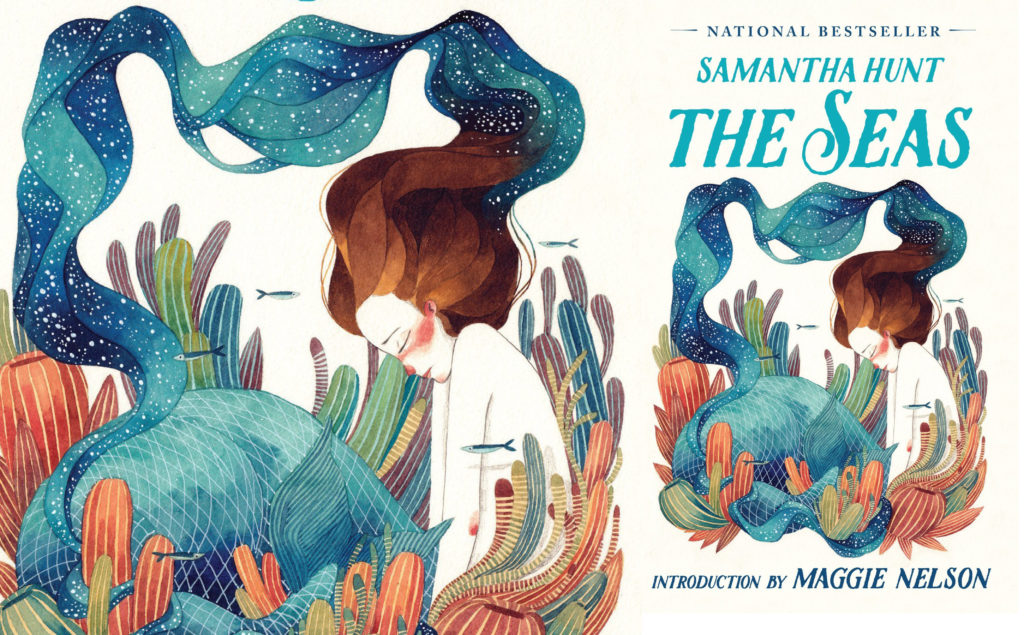The Seas: An Experience in Madness

Reading The Seas by Samantha Hunt is like being swept away by a beautiful and sometimes frightening lucid dream. Its first person point of view traps us in the perspective of a girl who alternates between moments of clarity and insanity. This perspective offers readers no distance from the experience of a woman unraveling—trapped in a town where she feels she doesn’t belong, she grieves the loss of her missing father, who one day wandered out into the ocean, never to be found. She maintains an unrequited love for Jude, an older soldier who is one of the many town drunks—and, even more compelling, the narrator is sure that she is a mermaid, that she comes from and will one day return to the sea. She takes on the qualities of the ocean, her body loose and fluid and swirling in the wake of her own loneliness and despair.
The Seas is a meditation on grief as liquid, uncontainable. The narrator slips from dreamlike trances into crystallized moments of despair, such as the moment she tries to drown herself in the bathtub in order to return to the sea and join her father. Then, in the next moment, a wave breaks, and we find ourselves again planted in reality, where she is lying in a hospital bed being recommended for psychiatric care. As the narrator says, “There is a lot of this kind of sadness here. It slips in like the fog at night. The fog that creeps out of the ocean to survey the land that one day she thinks will eventually be hers.”
First person point of view allows the narrator to dramatize her own mental unraveling. Her sanity ebbs and flows tidally, such as in the moment at the end of the book where she and Jude make love. I am there, riding the high of reality with her, or at least what I am led to believe is reality: “I kiss him back, his arms, his chest, his neck. I lift his shirt and I can taste his scars. He puts his hand on the small of my back and underneath one of my legs.” But a shift takes place in the small moment where she says she can “taste his scars.” The lovers are kissing and undressing, and the flow of the unreal creeps into the moment, taking over the narration: “I have never felt love in my lungs before. Jude looks like a horse. A seahorse. He is pushing up against me and inside me and every time I kiss him his lips are wetter than before. He is melting and he has been drinking so that I feel like I am rocking, like we’re on the sea.” Had this story been told in third person, I would have lost the immediacy of vacillating between the dreamy quality of love making into the dreamy quality of a woman losing her mind.
In The Seas, metaphors about ocean and grief turn me on my head from the very beginning, leaving me unsure of what I am seeing, what I am supposed to be seeing, what the narrator is experiencing in the real and unreal time of things. In the first chapter, “Maps,” where the narrator lays out the town and its dynamics for us, she presents a strange metaphor: “The town is built on a steep and rocky coast so that the weathered houses are stacked like shingles, or like rows of razor wire in a prison, one on top of the other up the hill.” Hunt moves between the real and the unreal seamlessly, creating a sense of uncertainty from the very beginning about what the narrator, and by extension the reader, is seeing. Is the narrator seeing the images of the town she came from overlaying the stark imagery of a prison? Or does the narrator see the town itself as a prison? Throughout the story we are given glimpses into the future by way of metaphor, but is it metaphor, or is it delusion? By the end of the story, I am unclear which is which. The water and sea metaphors continually call the narrator’s sanity into question.
The beauty of being in the perspective of the unreliable narrator is that the readers don’t know more than what she knows, and what she knows may be altogether different than what the truth is: “My mother sometimes works with me chambermaiding at the tourist motels, or we take on shifts at the sardine factory. They call us when they need us. At the factory, by 4 o’clock our hands are silver and slick from scales and soya oil. If I knit my fingers together my hands become odd fish themselves. They even try to swim away but I catch them.” Is this simply a metaphor that lends itself to the mystery of this place and of the woman who believes herself to be a part of the ocean? Or does she actually watch, mesmerized, as her fingers turn into fish? Part of the magic of this novel is that we never really know.
It is clear that the imagination of the protagonist is intrinsic to her nature, and it creates a dreamlike quality that shifts through the pages, swirling like the ocean that surrounds her. In one scene, the narrator is sure she has found a beached King Neptune; she works quickly to try to return the King to the sea, all along having an intimate conversation with the creature. I assumed that she was imagining the conversation with this giant sea creature, the same way we imagine having a conversation with our cat. Yet after she cuts her hand, the dream manifestation begins to disintegrate around her: “I push and push King Neptune and then I give up. And then I can see clearly. King Neptune isn’t, and underneath my cut hands is a rock shaped like a king, a rock deposited on the beach when the ice age flowed home, beaten, in retreat.” The propelling force in this story isn’t plot at all, but a fascinating, foreign, and terrifying series of flashes from someone who is experiencing multiple worlds stacked one on top of the other.
The narrator continually inhabits both real and imaginary worlds. I’m not entirely sure what is real, such as the character Jude, the older man she is in love with. The first time she sees Jude swimming out in the ocean until he is blue in the lips, she is sure that he is her father returned to her: “The possibility exists that one day the molecules of a body could arrange themselves just so that a person would be able to pass through a wall that appears solid to the eye. That is how much room we have between our molecules. I thought of that then I thought, ‘This is the place where all my father’s molecules went.’ Then Jude was coming out of the water and I thought, in quantum physics there might be a possibility that all the molecules of my father would find each other again and would walk out of the water looking at least a bit like him.” In this way, from the very beginning, Jude is a manifestation of both the love she has for her missing father and her love for the ocean, turning him into something other than what he actually is: a suffering drunken veteran. By the end, when she finally sleeps with Jude and hears his story only to wake and find him gone, I am utterly unconvinced of Jude’s existence at all, or what the narrator believes she is or isn’t experiencing. She finds Jude on the living room floor in the form of a puddle, and she drinks him, swallows him whole the way the grief of all the characters seems to be eating them alive. It isn’t until she devours her grief that she feels complete: “I feel buoyant. I feel light and ready. I feel like we are getting out of here and mostly I feel Jude inside of me and it feels like love.” When I later learn Jude is dead—was found dead on the living room floor where she drank up his body—I understand the deep level of the character’s dissociation and am left wondering: what was it that she drank? Was it Jude’s blood? Was she drinking anything at all, or was it the feeling of drowning?
Throughout the text, the narrator is preoccupied with the idea that she can’t see clearly: “I told her I was in love so badly that it was affecting my vision.” Her inability to see clearly, to think clearly, permeates the text as she returns again and again to the ophthalmologist who treats her as if she isn’t losing her mind: “I think the trouble with my eyes started because they don’t have enough pigment. They are more colorful than ice with a little blue in them. Eyes are an exception to ocean, sky, and blood. Eyes can be blue where there is no oxygen.” It becomes clear that what is clouding her vision is the color blue—the blue of sadness, of grief, of loneliness, of loss, of the waves swirling around her head, swirling round and round the place where she lives. The continual undercurrent of her inability to see properly, the sense that she believes it is love that is clouding her vision, brings me to understand more clearly the dissonance of the narration, that I only see what she can see, and what she sees is distorted by her own mental unstableness and by the reality which I know: that love and grief cloud my vision, that when I am swimming and open my eyes, my sight is blurry. What I think I see may be altogether different than what actually exists.
Through the first person narration of a character on the brink of insanity, Hunt gives us a portrait that can only be experienced from the outside. First person puts me in the realm of reality in a way that I may not experience otherwise, for the reality of an insane person is still their reality. Never before have I encountered a text that so fully embraces and encompasses the beautiful madness of breaking from reality—of what it means to really dream into the world that I live in. What I think I am experiencing, may in fact be something altogether different than the experience of another. What is making love to one is drowning to another. What is insanity may very well be reality.


